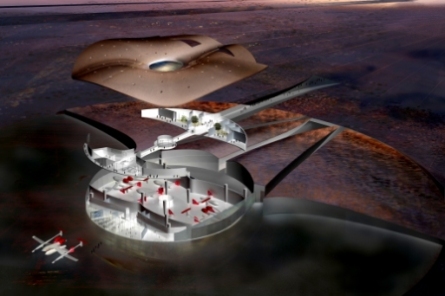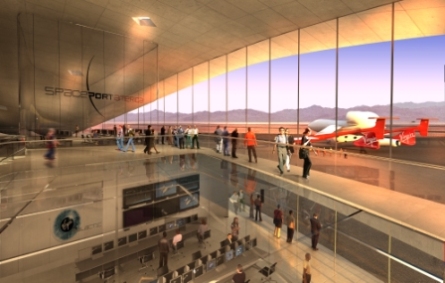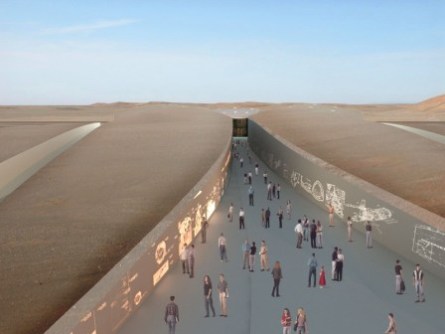The first images of New Mexico's Spaceport America have been released showing the expected design for the 9,290 square metre (100,000sq foot) facility that could see the first commercial suborbital flights by 2010.
 |
|---|
Above: The cutaway shows the hangar arrangement beneath the main terminal |
With spaceport construction expected to cost $198 million and to start in 2008, with completion by 2010, the port will host the headquarters of Virgin Galactic and the New Mexico Space Authority (NMSA).
 | |
|---|---|
Above: A Virgin Galactic SpaceShipTwo (SS2) flies over the spaceport surrounded by other SS2 and its carrier aircraft White Knight II |
NMSA is completing contract negotiations with the selected design team, US engineering company URS Corporation and UK architecture firm Foster + Partners. Once those contracts are completed NMSA and Virgin Galactic will finalise the spaceport's design with the team and then the tender process for construction contracts will begin in the first half of 2008.
However before construction can begin next year, under New Mexico government spaceport investment rules, the US Federal Aviation Administration has to issue an operator's licence to the NMSA.
 |
|---|
Above: A view from the main terminal looking out onto the hangar apron leading to the runway |
This low-lying shape is designed to resemble a rise in the landscape and its construction will use local technicques and materials. Dug into the landscape to provide a buffer against the extremes of the local climate, as well as catching the westerly winds for ventilation, its rolling concrete shell roof has windows that will give a view of the runway and spacecraft.
Visitors and the spaceflight participants, also to be described by Virgin Galactic as astronauts, enter the building through a deep channel cut in the landscape. The walls will form an exhibition area leading to a galleried level above the hangar that houses the spacecraft and on through to the terminal building. Natural light enters
via skylights, with a glazed façade reserved for the terminal building, establishing a platform for views onto the runway.
 |
|---|
Above: The entrance walls, part of a deep channel in the landscape, form an exhibition |
NMSA chair Kelly O’Donnell says: "The design created by the URS/Foster team is outstanding in the way it blends in with the environment, creating a shape that is both distinctive and functional while complementing the landscape."
Foster + Partners has experience in designing airports and glass and steel buildings worldwide, while URS is an engineering and design firm that has worked for the US government and has offices in the Americas, Asia-Pacific region, and Europe. Other elements of the spaceport, including roadways, runway, security, water, power and communication systems, are currently being designed by US civil engineering company DMJM: AECOM and related construction tenders will be released later this year.
Source: FlightGlobal.com
















